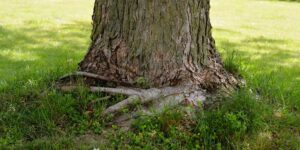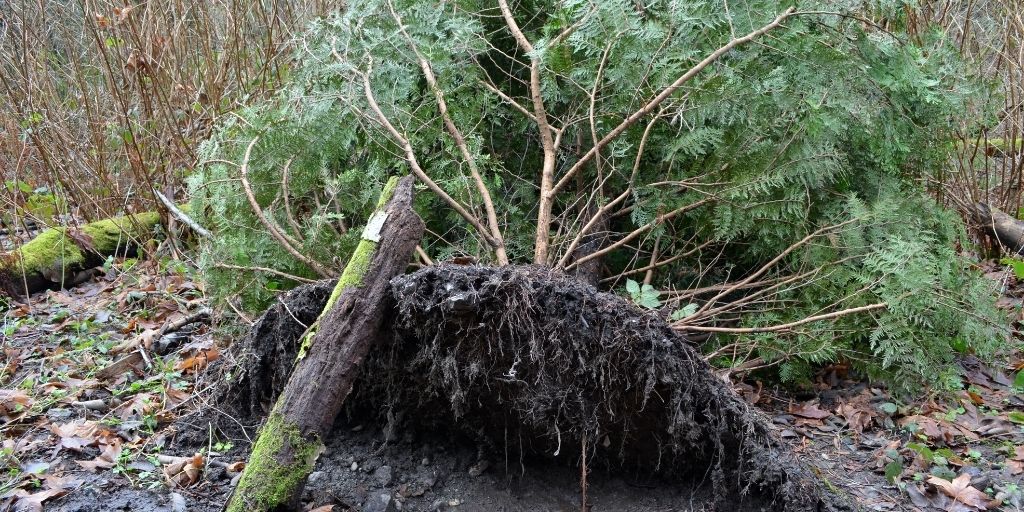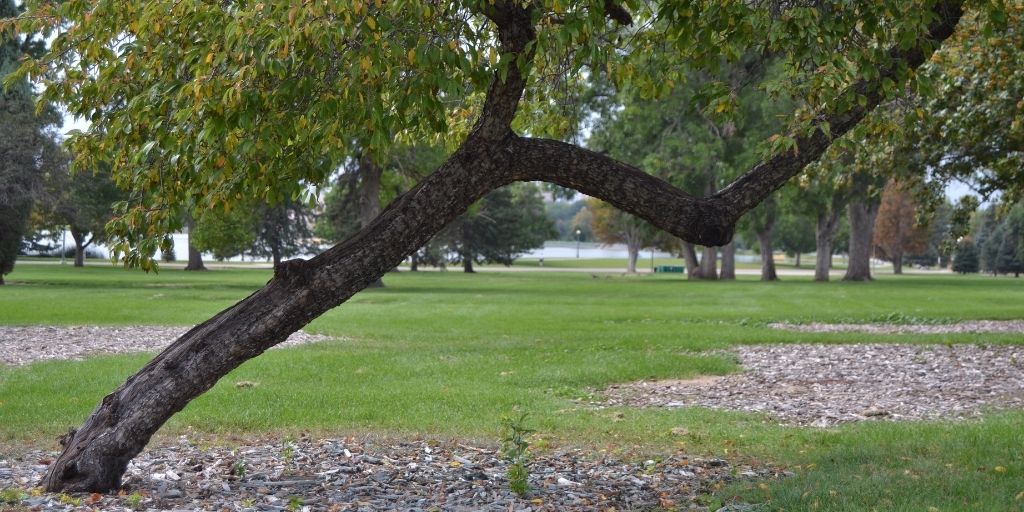One of the most common reasons why a tree starts to lean is because its roots are no longer able to fully stabilize it in the ground. Roots not only provide water, nutrients, and oxygen to the rest of the tree, but they also help to anchor the tree and keep it upright, even during intense storms or strong winds.
But what happens when tree roots cannot “hold onto” the soil around them? Or when there aren’t enough healthy roots to provide a solid foundation for the tree? And how can you tell if there’s a problem with your tree’s roots before it starts to lean or uproots?
While not all leaning trees can be prevented (we’ve all seen the tree damage caused by hurricanes and floods!), there are some simple things you can do to help your trees stay upright. After all, a leaning tree is a dangerous tree, so you’ll want to prevent it whenever possible.
In this article, we cover ways to help stabilize trees to lower the risk of your trees leaning or falling over. You’ll learn:
- How tree roots act as an anchor and the situations in which they cannot stabilize your tree (thankfully, you can prevent some of those situations – keep reading to learn how)
- Why your tree may start to lean when its roots are dying, damaged, or diseased
- How to keep tree roots healthy to prevent a leaning tree
- Other reasons why trees lean
- When to remove a leaning tree
…and more!
How Roots Stabilize Trees
If you’re wondering “why do trees lean?” the first thing you need to know is how roots stabilize trees.
Trees develop both widespread lateral roots (often extending two to three times wider than the tree canopy) and deeper anchoring roots. In some species, you’ll also see buttress roots against the trunk. The lateral roots branch and thin as they grow outward, with the root tips working into cracks and following small channels in the soil in search of water. Even finer root hairs branch out from the lateral roots and bind to material in the surrounding soil. Together, this huge network of roots works to firmly anchor the tree.
Why Roots Sometimes Fail to Stabilize a Tree
Trees are usually firmly anchored in the soil by their roots. But there are situations in which roots simply aren’t able to hold up the tree any longer.
Root Rot & Root Decay
Rotten and decaying roots is one of the most common problems leading to a leaning tree. It often happens when trees are growing in soil that’s too moist for them (not all trees like consistently moist soil). For example, standing water, poor drainage, and over-irrigation can all lead to root decay. As the roots rot, they lose their ability to provide water and nutrients to the tree, as well as their ability to “grip” the soil and stabilize the tree.
At first, you may just notice wilting or yellowing leaves. After a while, dead branches appear along the edges of the tree canopy and you may see mushrooms around the tree base. And, finally, the tree begins to lean as rotten roots give way.
Shallow Roots
When the soil is particularly moist or compacted, it encourages a tree to develop shallow roots. These don’t provide a strong anchoring system and are more prone to breakage and slippage, making the tree more susceptible to leaning.
If you’ve ever seen a fallen tree with a large, flat rootball still attached, you’ve seen the impact of growing a tree in compacted soil. This often happens near roadways, driveways, and other paved areas where traffic keeps the soil compacted.
Saturated Soil
When the soil becomes extremely saturated, such as during floods or heavy, prolonged rainfall, roots can start to lose their “grip”. As air spaces in the soil fill with water, it turns the ground into a thick, soup-like mess. Tree roots start to slip and slide as the upper parts of the tree move with the wind until, eventually, they pull out of the soil entirely and the tree topples.
How to Keep Tree Roots Healthy to Stabilize Your Tree
The best way to keep your trees upright is to keep their roots healthy with the following tips.
Water Properly
One is to watch the watering. Remember that trees growing in wet, heavily compacted soils are more likely to topple or lean when the weather is wet and windy. Overly wet soil is a major contributing factor to leaning trees so it’s a good idea to rectify this issue if you can.
Avoid overwatering – only water when the top few inches of soil are dry (the watering frequency will vary depending on the type of tree you are growing). Avoid watering the trunk directly, as this can lead to issues such as girdled roots. Instead, water at the drip line of a tree (around the outer reaches of the tree’s canopy).
Avoid Compacting Soil Around Trees
Preventing compacted soils can help keep roots healthy, too. The more compaction there is, the less space there is for oxygen. This encourages the roots to grow in a shallow fashion, making it harder for them to support the weight of the tree.
Avoid driving around your trees and address soil structure prior to planting your tree.
Plant Trees Properly
Improper planting is a major cause of early tree death – and leaning trees. Always plant at the correct depth, choose an appropriate location, only stake if necessary, and remove the wire basket and burlap (if present) before planting.
>> How to care for a newly planted tree
Protect Roots from Damage
Don’t cut roots, particularly large ones. Trees are much more likely to fall over if they’ve had roots damaged or cut, especially if they are within eight to ten feet of the trunk. This is an especially important tip to remember if you are doing any kind of construction or major landscaping projects near your trees.
Add Mulch Around Trees
Adding a layer of mulch (keep it about three inches away from the tree’s trunk) around your tree can also help keep its roots protected.
Mulch will keep the soil moist without causing it to become waterlogged. It maintains an even temperature while also preventing erosion – two other factors that can weaken roots and cause leaning trees.
Use organic mulch, like wood chips or shavings, to help return nutrients to the soil as the mulch decomposes.
>> Learn more about how to mulch trees
Address Drainage Issues
When you plant your tree, pay attention to the soil quality and moisture retention of the area. Don’t plant your trees in areas with standing water unless they’re specifically meant to be grown in those sorts of environments (such as weeping willows).
If you know that you have a problem with standing water, be proactive in dealing with it. You can divert water from trees with grading, drainage (such as a French drain), or trenching – but be careful not to damage the tree roots when you dig these features.
In many cases, though, diverting water away from your trees is as easy as diverting water from a downspout to a different area of your yard.
Other Reasons Why a Tree Might Lean
There are a few other reasons why a tree might lean. Fortunately, they’re easy to address by the tips mentioned above – and by contacting a tree care professional.
Some common reasons why a tree might lean include:
- It’s simply growing at an angle – When trees lean, they often do so because they are growing toward the sun. The tree trunk curves over time as the tree adapts to the changing availability of sunlight. As the trunk grows, the root system will grow to accommodate the off-center distribution of weight. This usually doesn’t result in a dangerous leaning tree, just one with a natural bend.
- Improper planting – When we remove a leaning tree, we often find that the root ball was never removed from the burlap or wire basket when the tree was planted, or that the tree was planted too deeply. As a result, the roots grew in circles around the tree (this is known as girdling) and cannot support the tree as it matures.
- Not enough space for roots – The roots were cut or simply did not have room to grow (for example, there could be a rock or foundation in the way, or the tree could be growing in a planting pit that’s too small).
- Something hit the tree and damaged it – For example, we’ve seen trees leaning after being hit by a car.
- Storm damage – Storms (including snowstorms and freezing rain) or high winds can cause trees to lean.
- Poor pruning – Pruning can imbalance the tree’s canopy; with more weight on one side, it can start to lean.
What to Do if a Tree is Leaning
If you’ve noticed a leaning tree, there are a few steps you should take.
Is the tree on your property? If not, you should put the owner of the property on notice of the tree. They might not know about the lean and so this is an important step to avoid potential injury or damages.
If the tree is on your property, your first step should be to get a professional inspection. Hire a certified arborist who can evaluate the tree’s condition and let you know the degree of risk it poses.
Then, you can decide on the best course of action to fix your leaning tree. Cabling, staking, guying, or bracing can sometimes help straighten it out. In some cases, the tree is simply leaning as part of its natural pattern of growth and can be left alone as long as it does not pose a risk.
>> How to tell if your tree is dangerous
Safety First
As soon as you notice that a tree is leaning, do your best to keep all people, cars, and objects away from it. If it seems to be leaning quite a bit or you can see the roots pulling out of the ground, contact emergency tree services immediately. A tree can fall unexpectedly – and you don’t want to be underneath it when it does.
Whatever the case may be, don’t attempt to cut the tree or modify it in any way to correct the lean (especially if it’s not on your property). There is a huge potential for liability and injury here. Again, consulting a Certified Arborist for a detailed assessment of the tree’s risk is the best way to go.
When to Remove a Leaning Tree
Generally, you can determine how dangerous a tree’s lean is by looking at the degree of change. If it has suddenly started to lean, that’s an indication that the roots have weakened or are broken. In that case, the tree usually needs to be removed.
If a tree is leaning more than 15% from vertical, no matter how sudden the change, that’s another indicator that it should be cut down.
Plan Ahead to Avoid Leaning Trees
The best way to deal with a leaning tree is to plan ahead. By planting the right tree in the right spot and providing your tree with the right amount of moisture and care, you can usually prevent it from tipping to one side.
Of course, you never know what Mother Nature will throw your way – and that’s where Alpine Tree can help. Contact us for a tree inspection (or emergency tree removal services) and for more information on how to prevent tree issues in the future.
Once a tree has started to lean, there’s often not much you can do, so prevention really is the best ”cure” for a leaning tree.







